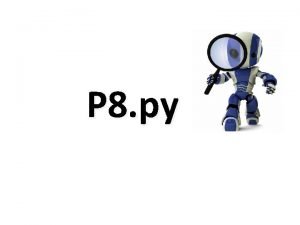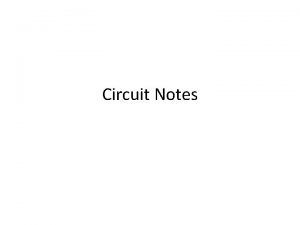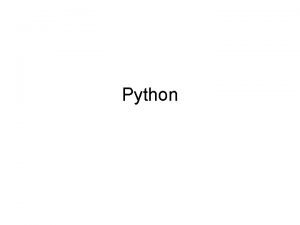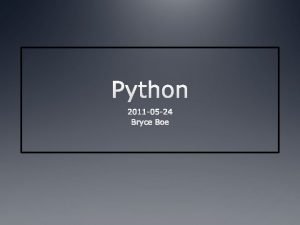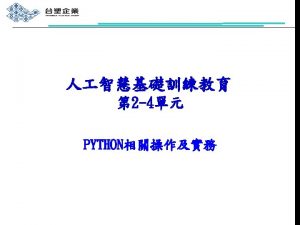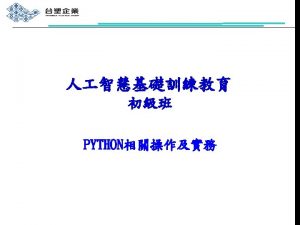Learn Circuit Python using the Adafruit Trinket M



































- Slides: 35

Learn Circuit. Python using the Adafruit Trinket M 0 PRESENTED BY RICHARD GOWEN (@alt_bier) Created for BSides. DFW 2020 HHV This Slide Deck Is Available at https: //altbier. us/circuitpython/

What is Circuit. Python? • Circuit. Python is a programming language designed to simplify experimenting and learning to code on low-cost microcontroller boards. • Circuit. Python is based on the Python programming language. • Python is a widely used high level language that is easier to read, write and maintain than low level languages like C. It supports modules and packages, has a built-in interpreter (which means no compiling), and is open source. • Circuit. Python adds hardware support to all these great features. • If you already have Python knowledge, you can easily apply that

What is the Adafruit Trinket M 0? • The Adafruit Trinket M 0 is a tiny microcontroller board that has been designed to work with Circuit. Python. Specs: • • • The Trinket is a hardware development board like • an Arduino and can even run Arduino code. • • • It comes shipped with Cicuit. Python firmware installed. So when you plug it in it will show up as • a very small disk drive with some files including main. py on it. Processor: Atmel ATSAMD 21 E 18 32 -bit 48 MHz Cortex M 0+ Flash: 256 KB RAM: 32 KB Native USB Support for both Arduino IDE and Circuit. Python 5 GPIO Pins • Analog input on 3 pins and true analog output on 1 pin • • PWM output on 3 pins Capacitive touch sensors on 3 pins

Adafruit and Circuit. Python Resources • The Adafruit website https: //www. adafruit. com/ is where you will find the documentation and other resources for their products. • You can purchase a Trinket M 0 here: https: //www. adafruit. com/product/3500 • Trinket M 0 Documentation: https: //learn. adafruit. com/adafruit-trinket-m 0 -circuitpython-arduino/ • The Circuit. Python website https: //circuitpython. org/ is a great resource for documentation and software and example code.

ELECTRONICS 101 Working with hardware development boards such as the Adafruit Trinket M 0 is easier if you have a basic knowledge of electronics concepts. This presentation will not provide that knowledge. However, I have put together a separate presentation that does. You can find my electronics overview presentation here: https: //altbier. us/electronics/

Mu Editor Software While an Integrated Development Environment is not required to work with Circuit. Python (any editor will work), Mu is a simple code editor that works with the Adafruit Circuit. Python boards. It has a built-in serial console, so you can get immediate feedback from your board's serial output. You can download it from https: //codewith. mu/ It is available for the Windows, Linux, Mac. OS, and Raspberry Pi operating systems.

Mu Editor Software The first time you start Mu, you will be prompted to select your 'mode' - you can change this later. If you are going to use Mu for the Labs presented here, you should select ‘Adafruit Circuit. Python’. Mu attempts to auto-detect your board, so plug in your Trinket M 0 device via USB and make sure it shows up as a drive named CIRCUITPY before starting Mu. Once your device is plugged in and Mu is started you are ready to write some code!

Serial Monitor To view the serial output of the Trinket M 0 or any Circuit. Python device you’ll need a serial monitor. In the Mu editor program there is a serial monitor built in that can be launched by clicking the ‘Serial’ button. If you’re not using that software, there are other ways to monitor the serial output. Look up the COM port number that your PC assigned to the Trinket when you connected it. Use a terminal program that supports serial connections (like Pu. TTY) and configure it to connect to the COM port at 9600 baud.

Connecting the Trinket M 0 When you connect the Trinket M 0 to your machine via USB is should open a small drive named CIRCUITPY. This drive is where you will place your code and libraries. It comes installed with a main. py file and some basic library files in a lib directory which are running demo code that will color cycle the on-board Dot. Star LED.

Verify the Trinket M 0 Firmware Version There are several versions of Circuit. Python firmware available, and the library files are not compatible between major versions (e. g. 2. x, 3. x, 5. x, 6. x, etc. ) So, you should verify the version of Circuit. Python firmware loaded on your Trinket M 0 before you start working with it. This is easily done by connecting it and opening a file named boot_out. txt in the root of the CIRCUITPY drive. This file will contain a line of text that shows the Circuit. Python version. Note that my Trinket M 0 came shipped with version 3. 1. 1 which I want to upgrade.

Upgrading the Trinket M 0 Firmware To update the firmware is a fairly simple process. • • Download the firmware file from https: //circuitpython. org/board/trinket_m 0/ • Click the ‘Download. UF 2 Now’ button to download the latest stable firmware version. • Note: The latest stable version at the time of this writing is 5. 3. 1 which is what we will use in these Labs. Connect the Trinket M 0 which will open a USB drive called CIRCUITPY. • • Optionally back up any. py files and the lib directory to your machine. Click the Reset button on the trinket twice. • Not like a mouse Double-click, but more like Click-pause-Click. • • You should see the Dot. Star LED turn green and a new disk drive appear called TRINKETBOOT. • The Red LED will flash then the TRINKETBOOT drive will disappear and the CIRCUITPY drive will reappear. • The main. py file and library files in lib may be deleted in this process. Copy the. uf 2 extension firmware file (e. g. adafruit-circuitpython-trinket_m 0 -en_US-5. 3. 1. uf 2) to the TRINKETBOOT drive.

Circuit. Python Library Files Whether you recently upgraded or just want to create a new project with your current version of Circuit. Python, you will want to download the library files for the version you are working with. Given the small amount of storage available it is important to only add the libraries you need to your device. You'll want the compiled library files available on your PC to allow you to keep file size down and copy only what you need when you need it. The library file bundle package is also a good source of example code covering various tasks.

Downloading Circuit. Python Library Files You can find the library file bundle packages for recent versions of Circuit. Python here: https: //circuitpython. org/libraries Choose the bundle that corresponds with your version and extract it. Now just copy any file you need from the lib directory.

Testing Trinket After Firmware Upgrade When you upgrade the Circuit. Python firmware it may delete your python code and library files, or worse leave them in place and nonfunctional. So, its best to clear any files and load new ones to test. There a few empty files that should be left on the CIRCUITPY drive since they are there to prevent your PC from storing hidden files on the tiny drive. These are: • . metadata_never_index • . Trashes • . fseventsd/no_log The lib directory can remain but should be empty.

Testing Trinket After Firmware Upgrade Create a file named main. py using Mu or your favorite editor. In the main. py file add the code shown on the right. This simple code will test that things are working. This code should blink the small Red LED in the corner of the board and print some text to serial output. It will also cause the RBG LED in the center of the board to light solid Green indicating that it is running a program without error. If the Red LED is not blinking or the RBG LED is not solid Green, then there is a problem. • Check that your indentation is consistent in main. py (Python is strict about indentation) import board import digitalio import time # Assign pin D 13 (On-Board Red LED) rled = digitalio. Digital. In. Out(board. D 13) # Set pin IO Direction rled. direction = digitalio. Direction. OUTPUT # Main Loop while True: # Serial Output print("Hello, Circuit. Python!") # Set LED state to ON rled. value = True # Pause for 1 second time. sleep(1) # Set LED state to OFF rled. value = False # Pause for 1 second time. sleep(1)

Troubleshooting Problems The Trinket M 0 and it’s Circuit. Python firmware will attempt to help you troubleshoot problems. The Dot. Star RGB LED will display a status color and flash an error code as shown on the right. Error messages are sent via serial output. So a serial monitor will allow you to see detailed error messages that will help you correct the problem. Note: The Mu editor has a built-in serial monitor that can interface with the Trinket M 0 and display these messages. The Trinket M 0 uses the Dot. Star RGB LED on the board to indicate the status of Circuit. Python. Here is how to read it: • steady GREEN: main. py is running • pulsing GREEN: main. py has finished or does not exist • steady YELLOW at start up (4+) Waiting for a reset to indicate that it should start in safe mode • pulsing YELLOW: In safe mode – (crash & restart) • steady WHITE: REPL is running • steady BLUE: boot. py is running Colors with multiple flashes following indicate a Python exception and then indicate the line number of the error. The color of the first flash indicates the type of error: • GREEN: Indentation. Error • CYAN: Syntax. Error • WHITE: Name. Error • ORANGE: OSError • PURPLE: Value. Error • YELLOW: other error These are followed by flashes indicating the line number. WHITE flashes are thousands' place, BLUE are hundreds' place, YELLOW are tens' place, and CYAN are one's place.

Integrating Circuits with the Trinket M 0 So far, we haven't connected our Trinket to anything. To have it control external circuits it must be integrated into those circuits. To do this we will connect our external circuits to pins on the Trinket. In addition to internal pins (such as those for the onboard LEDs), the Trinket has ten external physical pins that we will use with our external circuits. There are five general purpose input / output (GPIO) pins labeled 0 thru 4. These each have different features that should be considered (e. g. digital, analog, PWM, touch sensor, etc. ) The other five pins include a voltage input pin labeled ‘Bat’, two voltage output pins labeled ‘USB’ (5 V) and ‘ 3 V’, a ground pin labeled

Pinout of the Adafruit Trinket M 0 This pinout diagram details which pins have which features.

Working with Circuit. Python on the Trinket M 0 Circuit. Python is based on Python 3. So, most things that work with Python 3 will work with Circuit. Python libraries are separate files designed to work with Circuit. Python code. Circuit. Python programs require a lot of information to run. Circuit. Python is so simple to use because most of this information is processed in the background and stored in libraries. Some libraries are built into Circuit. Python. Others are downloaded and stored on your CIRCUITPY drive in a folder called lib. Circuit. Python looks for a code file on the board to run in the root of the CIRCUITPY drive. There are four options: code. txt, code. py, main. txt and main. py. Circuit. Python looks for those files, in that order, and then runs the first one it finds. Any editor will work to modify the code. Whether you are editing the file directly on the CIRCUITPY drive or copying a code file there, when you

Python Quick Reference

CIRCUITPYTHON TRINKET PROJECTS This next section will outline some Circuit. Python projects using the Trinket M 0. These projects will be centered around two different physical circuit layouts with several Circuit. Python code blocks for each. • • Adafruit Trinket LED Control – Lab HHV 2020_04 • • Blink the on-board Red LED Blink both external and on-board LEDs Fade external LED on/off using PWM Turn LEDs on/off using a Tactile Switch Adafruit Dot. Star RGB LED and Touch Sensor – Lab HHV 2020_05 • • Blink the on-board Dot. Star RGB LED Color Cycle the on-board Dot. Star RGB LED Use Touch Sensor to Control an external LED Use Touch Sensor to Color Change the on-board Dot. Star RGB LED The Lab reference numbers refer to the BSides. DFW Hardware Hacking Village Videos which can be accessed here: https: //altbier. us/bsidesdfw. HHV 2020/

ADAFRUIT TRINKET LED CONTROL Schematic LAB HHV 2020_04

ADAFRUIT TRINKET LED CONTROL Physical Layout Strip Board Connection Details • Trinket – I 17 -21 and J 17 -21 • Resistor 100 Ohm – D 19 and H 19 • LED • • • Wire up a circuit as shown in the schematic and physical layout. Components: • 1 x Resistor 100 Ohm • 1 x Resistor 10 K Ohm • 1 x LED 5 mm • 1 x Tactile Switch SPST LAB HHV 2020_04 • • Anode – C 19 Cathode – B 19 Wire – A 19 and VCC 19 Wire – E 18 and VCC 18 Switch SPST 4 Pin • • Pin A(1) – N 14 Pin B(1) – Q 14 Pin C(2) – N 16 Pin D(2) – Q 16 • • • Wire – R 16 and N 21 • Wire – A 20 and VCC 20 Wire – M 14 and H 20 Resistor 10 K Ohm – E 20 and B 20

ADAFRUIT TRINKET LED CONTROL Blink the on-board Red LED This simple bit of code will blink the on-board Red LED. This is the same code shown on the ‘Testing Trinket…’ slide. Let's walk through what it is doing: Lines 1 -3 import the library files we will use. These libraries are built into Circuit. Python so they will not be in the lib directory. Line 5 assigns pin Digital-13 to an object named rled. This is the pin associated with the Red LED. Line 7 sets the IO pin direction to OUTPUT Line 9 starts the main While loop that will run indefinitely. Line 11 prints a string to the serial output. You can see this text output with a serial monitor. Line 13 sets the value of rled to True which turns ON the LED. Line 15 pauses the program for 1 second Line 17 sets the value of rled to False which turns OFF the LED. Line 19 pauses the program for 1 second This Code Is Available Here: LAB HHV 2020_04

ADAFRUIT TRINKET LED CONTROL Blink both external and on-board LEDs This simple bit of code is like the previous code, adding an external LED. It will blink both the on-board and external LEDs Let's walk through what it is doing: Lines 1 -3 import the library files we will use. Line 5 assigns pin D 13 (on-board LED) to an object named rled. Line 7 assigns pin D 4 (external LED) to an object named led 4. Line 9 -10 sets the IO pin direction to OUTPUT for both pins Line 12 starts the main While loop that will run indefinitely. Line 14 sets the value of both LEDs to True which turns them ON. Line 16 prints strings and values to the serial output. Line 18 pauses the program for 1 second This Code Is Available Here: LAB HHV 2020_04

ADAFRUIT TRINKET LED CONTROL Fade external LED on/off using PWM In the previous code we defined a digital output pin for our LED. In this code we define a PWM (Pulse Width Modulation) output pin which mimics analog allowing the LED to be in between ON or OFF. Let's walk through what's different: • We import the pulseio instead of the digitalio library. • We assign the led 4 object to a PWMOut which is output only so we don’t set a direction. • We use for loops with a range of 100. The first loop iterates up to fade the LED ON, the second iterates down to fade it OFF. • Instead of setting a value of True(HIGH) or False(LOW) we are setting the duty_cycle which represents the This Code Is of Available Here: percentage time the pin will be in the HIGH state. The LAB HHV 2020_04

ADAFRUIT TRINKET LED CONTROL Turn LEDs on/off using a Tactile Switch This code will read the state of a tactile switch (button) and use that to control the LEDs turning them on when pressed. We will use the button value in two ways, as a conditional check and as a raw value to send to an object (an LED). Let’s look at the key items in this code: • Assign rled and led 4 pins as digital output • Assign sw 1 pin as digital input • Read in the sw 1 value and print it to serial • Use an if conditional statement to check if sw 1 is True and set rled to True (LED ON) if it is, else set it to False (LED OFF) • Set led 4 to be equal to sw 1 value (True or False, ON or OFF) This Code Is Available Here: LAB HHV 2020_04

LAB HHV 2020_05 ADAFRUIT DOTSTAR RGB LED AND TOUCH SENSOR Schematic

LAB HHV 2020_05 ADAFRUIT DOTSTAR RGB LED AND TOUCH SENSOR Physical Layout Strip Board Connection Details • Trinket – I 17 -21 and J 17 -21 • Resistor 100 Ohm – K 20 and O 20 • LED • • Wire up a circuit as shown in the schematic and physical layout. Components: • 1 x Resistor 100 Ohm • 1 x LED 5 mm • 1 x Bare Wire (for touch) • • Anode – P 20 Cathode – Q 20 Wire – R 20 and VCC 20 Bare Wire – K 19 and O 19

LAB HHV 2020_05 ADAFRUIT DOTSTAR RGB LED AND TOUCH SENSOR Circuit. Python Library Files Needed The code used in the following examples will require some library files that are not built into Circuit. Python. You can find the library file bundle packages for recent versions of Circuit. Python here: https: //circuitpython. org/libraries Download the bundle for the version you are working with (5. x) and extract it in a directory on your PC. Locate these two library files on your PC and copy them to the lib directory on the CIRCUITPY drive: • adafruit_dotstar. mpy • adafruit_pypixelbuf. mpy

LAB HHV 2020_05 ADAFRUIT DOTSTAR RGB LED AND TOUCH SENSOR Blink the on-board Dot. Star RGB LED This code will blink the on-board Dot. Star RGB LED. This uses some library files not included in Circuit. Python. Let’s look at the key items in this code: • Import adafruit_dotstar library • It calls the library adafruit_pypixelbuf • Assign dot object data pin APA 102_SCK, clock pin APA 102_MOSI, pixel_num=1, and brightness=0. 2 • Note: The board lib defines pins D 7 & D 8 as different names • Set the Value of dot[0] to Red, Green, Blue, then OFF using a value list formatted (R, G, B) with values 0 -255 This Code Is Available Here:

LAB HHV 2020_05 ADAFRUIT DOTSTAR RGB LED AND TOUCH SENSOR Color Cycle the on-board Dot. Star RGB LED This code will Color Cycle the on-board Dot. Star RGB LED. Let’s look at the key items in this code: • Import adafruit_dotstar library • Assign dot object data pin APA 102_SCK, clock pin APA 102_MOSI, pixel_num=1, and brightness=0. 2 • Define a function wheel(pos) that will take an integer and return a list formatted (R, G, B) with values 0 -255 • Set dot[0] to the value that wheel(i) returns • Increment the var i keeping it between 0 -255 • Pause briefly between color changes. This Code Is Available Here:

LAB HHV 2020_05 ADAFRUIT DOTSTAR RGB LED AND TOUCH SENSOR Use Touch Sensor to Control an external LED This code will use a Capacitive Touch Sensor to control and external LED turning it on when touched. Let’s look at the key items in this code: • Import touchio library • Assign touch object to Touch. In analog pin A 0 • Read the value of touch • Use an if conditional statement to test for a touch. • Given that the touch pin is analog it will register values all the time and we must set our test value higher than ambient values • If a touch is registered set led 5 to True turning it ON • Pause very briefly between loops. This Code Is Available Here:

LAB HHV 2020_05 ADAFRUIT DOTSTAR RGB LED AND TOUCH SENSOR Use Touch Sensor to Color Change the Dot. Star RGB LED This is the same code we used earlier to Color Cycle the Dot. Star RGB LED with a slight modification to add touch. The color will now only cycle when touched staying steady at its current color when not touched. Let’s look at the key items added to the existing code: • Added the touchio library import • Assign touch object to Touch. In analog pin A 0 • Read the value of touch • Use an if conditional statement to test for a touch and increment the iteration variable i only if touched This Code Is Available Here:

THANK YOU I hope you enjoyed this presentation and learned something from it. -- @alt_bier This Slide Deck – https: //altbier. us/circuitpython/ Code – https: //github. com/gowenrw/BSides. DFW_2020_HHV/
 Trinket.io
Trinket.io Revision techniques for kinesthetic learners
Revision techniques for kinesthetic learners Let's learn python
Let's learn python Meet tina trinket
Meet tina trinket Series circuit disadvantages
Series circuit disadvantages Types of electrical circuits
Types of electrical circuits Circuit construction kit
Circuit construction kit Parallel vs series
Parallel vs series What is a incomplete circuit
What is a incomplete circuit Voltage in parrallel
Voltage in parrallel Formula for venn diagram with 3 circles
Formula for venn diagram with 3 circles Pulmonary circuit and systemic circuit
Pulmonary circuit and systemic circuit What is a parallel circuit in physics
What is a parallel circuit in physics Polynomial addition using array in data structure
Polynomial addition using array in data structure Pyautogui web browser
Pyautogui web browser Spark streaming twitter sentiment analysis
Spark streaming twitter sentiment analysis 8-puzzle problem using heuristic function in python
8-puzzle problem using heuristic function in python Polynomial adt
Polynomial adt Laplace transform electrical circuit analysis
Laplace transform electrical circuit analysis Inductor laplace
Inductor laplace Combinational circuit design and simulation using gates
Combinational circuit design and simulation using gates Combinational circuit design and simulation using gates
Combinational circuit design and simulation using gates Design a combinational circuit using rom
Design a combinational circuit using rom Find v
Find v Hát kết hợp bộ gõ cơ thể
Hát kết hợp bộ gõ cơ thể Ng-html
Ng-html Bổ thể
Bổ thể Tỉ lệ cơ thể trẻ em
Tỉ lệ cơ thể trẻ em Chó sói
Chó sói Thang điểm glasgow
Thang điểm glasgow Bài hát chúa yêu trần thế alleluia
Bài hát chúa yêu trần thế alleluia Các môn thể thao bắt đầu bằng tiếng nhảy
Các môn thể thao bắt đầu bằng tiếng nhảy Thế nào là hệ số cao nhất
Thế nào là hệ số cao nhất Các châu lục và đại dương trên thế giới
Các châu lục và đại dương trên thế giới Công của trọng lực
Công của trọng lực Trời xanh đây là của chúng ta thể thơ
Trời xanh đây là của chúng ta thể thơ
















